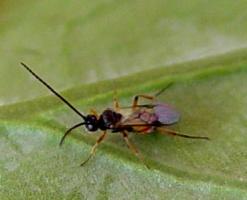Diamondback moth (DBM)
 |
Diamondback moth (DBM)
Scientific name:
Plutella xylostella
Family:
Lepidoptera: Plutellidae
Local names:
Tanzania: Nondo mgongo-almazi (Kishwaheli); Kenya: Kimbaru twa (Kikamba), Kihuruta (Kikuyu), Kirinyo (Kimeru)
Type:
pest (insect/mite)
Host plants: Cabbage/Kale, Brassicas
broccoli, Brussels sprouts, cauliflower, Chinese cabbage, kale, kohlrabi, mustard, rape, savoy, swede, turnip
|
Geographical distribution
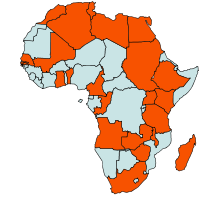 |
| Geographical Distribution of the Diamondback moth in Africa (red marked) |
Damage
 |
| Cabbage damaged by diamondback moth |
| © A. M. Varela, icipe |
Host Range
Broccoli, cabbage, cauliflowers, and other brassica crops. In Kenya, diamondback moth has also been found feeding on peas. Symptoms
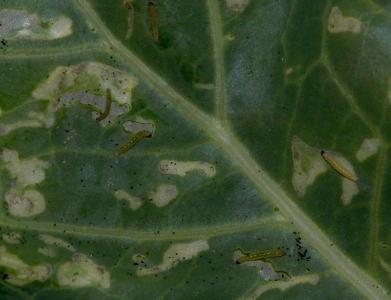 |
| Diamondback moth - Young caterpillars and their damage |
| © A.M. Varela, icipe |
Affected plant stages
Seedling stage, vegetative growing stage, flowering stage and fruiting stage. Affected plant parts:
Fruits/pods, growing points, inflorescence, leaves and stems. 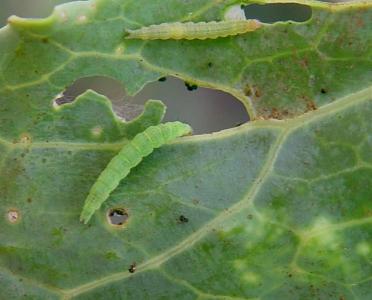 |
| Diamondback moth caterpillars feeding on kales |
| © A. M. Varela, icipe |
 |
| Eggs of the diamondback moth |
| © F. Haas, icipe |
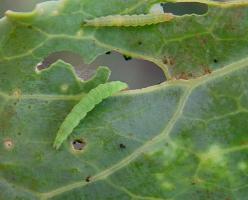 |
| Diamondback moth caterpillars feeding on kales |
| © A. M. Varela, icipe |
The caterpillars go through four instars and complete their development and pupate in 10 to 28 days. Diamondback moth (DBM) caterpillars are easily identified because they wriggle violently when disturbed, drop from the plant suspended by a silken thread and finally climb their way back up and continue feeding.
 |
| Diamondback moth pupal colour changes to brown before adult emergence. The developing moth can be seen through the cocoon. The pupa is 5 to 6 mm long. |
| © A. M. Varela, icipe |
The moths emerge 3 to 15 days after pupation depending on the environmental conditions.
 |
| Diamondback moth adult on cabbage leaf. The adult is greyish brown with a nine mm long body and a wingspan of about 1.2 to 1.5 cm |
| © Alton N. Sparks, Jr., The University of Georgia, www.insectimages.org |
Diamondback moth infestations tend to be serious in the dry months. Heavy rains may reduce populations dramatically, thus this pest is less likely to be a problem in wet years and during rainy seasons. Diamondback moth populations can increase rapidly at temperatures above 26°C.
 |
| © A. M. Varela. icipe |
Pest and disease Management: General illustration of the concept of infonet-biovision

Further below you find concrete preventive and curative methods against Diamondback moth (DBM).
Monitoring
Inspect the crop regularly. Diamondback moth populations can increase rapidly in warm conditions. Therefore, it is important to scout for DBM moth regularly, at least twice a week. Diamondback moth caterpillars are detected by visual observations of the plant. (Adults can also be detected by the use of pheromone traps though they are not yet available in East Africa.)
Scouting should begin when the plants are young; the earlier the pest is discovered, the easier it is to control. Plants should be checked thoroughly. Growing points should be carefully examined. Caterpillars that are inside the cabbage head are difficult to detect unless outer leaves are pulled back. When scouting, it is important to record presence of parasitic wasps and parasitised caterpillars. Please also refer to section on natural enemies under Biological Pest Control further down on this page.
Examples of economic thresholds
Economic thresholds for the diamondback moth have been developed in several countries. For example, in small cabbage plots (0.25 ha) in Honduras, it is recommended to sample at least 60 plants and the action threshold is one caterpillar per plant. Broccoli and cauliflower at the vegetative stage can support 30% defoliation. At harvest time, an infestation level of one caterpillar per head is the action threshold (Rueda and Shelton, 1995). In the Midwest (USA), the treatment threshold for caterpillars (including DBM) attacking cabbage is given as 10% of infested pants in the seedbed, 30% infested plants from transplant to cupping stage, 20% infested plants from cupping to early heading, and 10% infested plants at early heading to mature head stages. For processing cabbage, which will be trimmed and shredded, more injury is tolerable; treatment is advised at 75% infestation. The treatment thresholds for broccoli and cauliflower are: 10% plant infestation in the seedbed, 50% plant infestation from transplant to first flower, and 10% infestation from first flower to maturity (Foster and Flood, 1995).These thresholds are given as examples. However, note that economic thresholds depend on many factors (crop stage, crop age, and economic and climatic conditions) and cannot be adopted without taking into consideration local conditions.
Sanitation
- Start with a healthy crop. Place seedling beds away from production fields to minimise attack by the diamondback moth. Transplant only healthy seedlings, which are free of eggs, caterpillars and pupae of the diamondback moth and other pests.
- Remove and destroy or plough down crop residues in seedling beds and production fields.
These practices will prevent build-up of the diamondback moth and migration to nearby fields.
Pest avoidance
Planting cabbage at the beginning of the rainy season can help to avoid problems with the diamondback moth. Heavy rains reduce flight activity and mating of moths and wash off caterpillars and pupae from plant leaves. However, in the rainy season the plants will be more prone to diseases such as black rot, downy mildew and ring spot.Crop rotation
Crop rotation can be effective in controlling the diamondback moth in semi-arid environments as there are only very few wild host plants. A significant reduction in the numbers of caterpillars can be achieved by having a break of 6 weeks or more where no brassica crops (cabbage, broccoli, cauliflower among others) are grown at all. It is important that all farmers in a locality, or at least close neighbours, follow crop rotation simultaneously. This break will disrupt the pest's breeding cycle. Therefore, brassica crops planted after this break will be safe from the pest for sometime. However, this does not work in the highlands where large numbers of wild host plants are present in the surroundings of the fields throughout the year.
Intercropping, trap cropping
Planting rows of tomatoes alternately with rows of cabbage is reported to reduce damage but it does not prevent the attack completely. Kenya Institute of Organic Farming recommends this method as effective. In addition, cabbages would repel the tomato bollworm, making this practice serve a double purpose. Intercropping with chillies is said to repel diamondback moth adults (Dobson et al, 2002).
Trap crops such as mustard and rape can also be useful to reduce diamondback moth attacks. Fifteen rows of cabbage followed by mustard rows have been shown to be most effective (HDRA, 2000). Bold seeded Indian mustard could also be sown densely all around the area 10 days before the crucifers are planted. The plants attract up to 80% diamondback moths (IPM Bulletin of Pest Management, Undated). However, trap crops should be frequently monitored so as to control this pest before it can move to the main crop. Once the trap crop is infested it can be ploughed in or removed. Unattended trap crops can generate large populations of diamondback moth.
Care is needed to manage intercrops in order to use them as part of a control practice (Shelton et al., 1995).
Irrigation
As with rain, frequent overhead irrigation disrupts moth activities and washes off caterpillars from the plants. However, use of sprinkler irrigation may lead to increase of diseases such as black rot and downy mildew.Habitat management
Managing the habitat or the way a crop is grown helps to prevent or reduce pest and disease. Mix cropping brassica crops with some other crops or plants (intercropping, trap crops, strip cropping) has been shown to reduce infestation by the diamondback moth. The plants to be grown together with the brassica crops need to be carefully selected. Oniona and tomatoes can be intercropped with brassicas.Maintaining natural surroundings, including trees and shrubs help to conserve natural enemies by providing shelter and plenty of breeding places for them. Maintaining strips of local flowering plants in the vicinity of the brassica crops is useful for beneficial insects. Trap cropping with flowering mustard can also augment the number of beneficial insects in the trap crop and the neighbouring crops.
Natural enemies
Natural enemies (local and imported) can help to keep the pest at acceptable levels if they are conserved and their activity encouraged. Habitat management and avoidance of broad-spectrum insecticides early in the season, when the diamondback moth is present in low numbers may preserve natural enemies that can help keep diamondback moth and aphid populations under control later in the season. Many natural enemies prey on the diamondback moth at different stages of its life cycle. Birds and spiders feed on moths; ants, lacewings, wasps, and parasitic wasps among others attack the caterpillars.
Numerous parasitic wasps attack diamondback moth. The most common are wasps of the genus Cotesia, Diadegma, Diadromus and Oomyzus. These wasps are also known from Africa and some are reported to effect excellent control of the diamondback moth elsewhere.
Unfortunately, the locally existing wasps do not provide satisfactory control of the diamondback moth in eastern and southern Africa. For this reason, two species of wasps (Diadegma semiclausum and Cotesia plutellae) were imported and released by ICIPE in Kenya, Uganda and Tanzania. The former has provided almost complete control of this pest in highland growing conditions while the second is specific to mid-altitude, semi-arid areas where it also provides good control.
|
|
|
It is important to distinguish parasitised diamondback moth caterpillars from healthy ones. Caterpillars parasitised by Diadegma semiclausum can be distinguished at the pupal stage. The larva of this parasitic wasp eats the diamondback moth caterpillar from inside and pupates inside the diamondback moth cocoon. The pupa of the parasitic wasps appears as a round elongated brown capsule within the diamondback moth cocoon. In contrast, it is possible to see the developing moth through the cocoon of a healthy pupa.
The larva of Cotesia plutellae feeds inside the diamondback moth caterpillar and emerges from the caterpillar to pupate in a silky cocoon on the leaves near the dead diamondback moth caterpillar.
|
|
Pathogens including fungi, bacteria and viruses are naturally found causing diseases to the diamondback moth in the field. However, they generally occur during rainy seasons when problems with this pest are not very pronounced. There are some commercially available pesticides based on disease-causing microorganisms (microbiological pesticides). A well-known example is Bacillus thuringiensis (Bt).
For more information on natural enemies click here.
Bt (Bacillus thuringiensis)
Bacillus thuringiensis var. aizawai and Bt var. kurstaki are very effective in controlling infestations of the diamondback moth. Bt var. kurstaki is widely used at a weekly interval and a rate of 0.5/ha. This type of strategy provides effective control of this pest. However, continuous use of Bt can induce development of resistance. Bt kills the diamond back moth and does not harm beneficial insects. Bt insecticides should be applied when the newly hatch caterpillars appear. Sprays may need to be applied at intervals of 5 to 7 days when populations are high. Because Bt insecticides are UV-degraded treat crops in the late afternoon. For more information on Bt click here.
Farmers experience
Farmers in some countries produce their own homemade biopesticides by collecting diseased diamondback moth caterpillars (fat and white or yellowish or with fluffy mould on them), crushing them and mixing them with water in a blender. Large tissue clumps are filtered out and the liquid is sprayed onto the crop (Dobson et al, 2002).Neem (Azadirachta indica)
Neem-based products give a good control of the diamondback moth and are relatively harmless to natural enemies and non-toxic to warm-blooded animals. Since the action of neem is relatively slow, caterpillars may survive for a few days after application, but their growth and feeding is inhibited and they do not cause further damage to the crop. For more information on Neem click here.
- CABI. (2004). Crop Protection Compendium, 2004 Edition. © CAB International Publishing.Wallingford, UK.www.cabi.org
- Cornell International Institute for Food, Agriculture and Development. Global Crop Pests. Rueda and Shelton. Diamondback moth (DBM). www.nysaes.cornell.edu
- Foster R. and Flood, B. (1995). Vegetable insect management with emphasis on the Midwest. Purdue Research Foundation. Meister Publishing Company, Willoughby, Ohio. ISBN: 0-931682-52-2.
- HDRA (2000). Diamondback moth, Plutella xylostella. Pest Control No. TPC3. Tropical Advisory Service, HDRA,UK. www.gardenorganic.org.uk
- ICIPE www.icipe.org
- Natural Resources Institute, University of Greenwich, UK (2002): Integrated Vegetable Pest Management. Safe and sustainable protection of small-scale brassicas and tomatoes. By Hans Dobson, Jerry Cooper, Walter Manyangarirwa, Joshua Karuma and Wilfred Chiimba. ISBN: 0-85954-536-9.
- Oisat. Organisation for Non-Chemical Pest Management in the Tropics. www.oisat.org
- Rushtapakornchai, W., Vattanatangum, A. and Saito, T. (1992). Development and implementation of sticky trap for diamondback moth control in Thailand. In: Talekar NS, ed. Diamondback Moth and Other Crucifer Pests: Proceedings of the Second International Workshop. Shanhua, Taiwan: Asian Vegetable Research and Development Center, 523-528. www.avrdc.org
- Shelton, A.M., Turner, A., Giga, D. Wilkinson, P., Zitzanza, E. and Utete, D. (1995). Diamondback moth. Zimbabwe Horticultural Crops Pest Management. NYSAES, Geneva NY. 2pp.
- Talekar, N. S. and Shelton, A. M. (1993). Biology, Ecology and Management of Diamondback Moth. Annual Review of Entomology, Volume 38. http://web.entomology.cornell.edu

